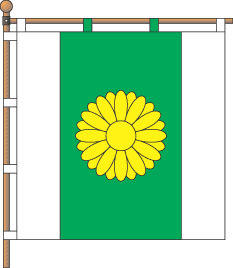 (1:1)
(1:1)image from the site of Ukrainian Heraldry

Last modified: 2018-12-15 by rob raeside
Keywords: rivne | pidluzhne | podluzhne | kostopil' | flower | coltsfoot |
Links: FOTW homepage |
search |
disclaimer and copyright |
write us |
mirrors
 (1:1)
(1:1)
image from the site of Ukrainian
Heraldry
See also:
From the site of Ukrainian
Heraldry:
"It was confirmed in July, 12th, 2006 by the decision #26 of
village council session. The square panel, which consists of
three vertical strips - white, green and white (parity of their
width is equal to 1:3:1), in the middle of the green strip is
yellow flower of mother-and-stepmother."
Dov Gutterman, 5 November 2007
The plant is Tussilago farfara L. (Family
Asteraceae), the coltsfoot. This vernacular name refers to the
shape of the leaves, also frequently refered to in other
languages: Catalan (pota de cavall, horse's foot),
Danish (folfod, foal's foot), Dutch (hoefblad,
hoof leaf), French (pas d'ane, donkey's foot), Norwegian
(hestehov, horse's hoof), Spanish (pie de caballo,
horse's foot; una de caballo, horse's hoof), Swedish (hasthov,
horse's hoof).
The writer Apuleius (AD 123/125- AD 180) already used
the Latin name of the plant, tussilago, reflecting its
therapeuthical use (from "tussis", "cough",
and "ago", "I dispel"). The origin of farfara
is obscure.
Coltsfoot, characteristic of unstable soils, form patches in
environments with a high level of disturbance. The flowers appear
on the stem long before the leaves, therefore the medieval Latin
name of the plant "filius ante patrem", the son before
the father.
On her "Moscow
Daily Photo" blogsite, "Irina" shows a
photography of the plant and gives the explanation of its Russian
vernacular name, "mother-and-stepmother": "In
Russian this flower is called by what can be translated as
"mother- and-stepmother". That is because of its
leaves: soft and gentle on one side (like mother), they are rough
and unpleasant on the other (like step-mother)."
Botanically, what is shown on the flag is not a flower but a
calathid, a.k.a capitulum or flowerhead, indeed a cluster of
numerous flowers. This compound structure was the origin of the
former name of Family Asteraceae, Compositae (former but still
valid acording to Article 18.5 of the International Code of
Botanical Nomenclature).
Ivan Sache, 4 July 2008
35023.gif)
image from the site of Ukrainian
Heraldry
From the site of Ukrainian
Heraldry:
"It was confirmed in July, 12th, 2006 by the decision #26 of
village council session. In the center of vert shield with argent
wavy dexter and sinister flanks is or flower of
mother-and-stepmother. The shield enframed by or cartouche and
crowned by or village crown. The authors are Yu.Terlets'kyi,
A.Grechylo, M.Omel'chuk, O.Kosobyts'kyi.
Flower and vert field specifie the village name and generous
meadows, argent flanks mean Horyn' and Zamchys'ko rivers, because
village lays between them.
Yu.Terlec'kyi, A.Grechylo. "The modern symbols of
Kostopil's'kyi region"."
Dov Gutterman, 5 November 2007
From the site of Ukrainian
Heraldry:
"The first houseshave appeared there near the Horyn' river
banks on the wide meadow. Name occured by words "near
meadow" - "pid lugom"."
Dov Gutterman, 5 November 2007